Answered step by step
Verified Expert Solution
Question
1 Approved Answer
1. Summarize the case. 2. Explain relevant theories, concepts, and models from the textbook. 3. Identify the relevant stakeholders and explain their position/perspective. 4. Explain

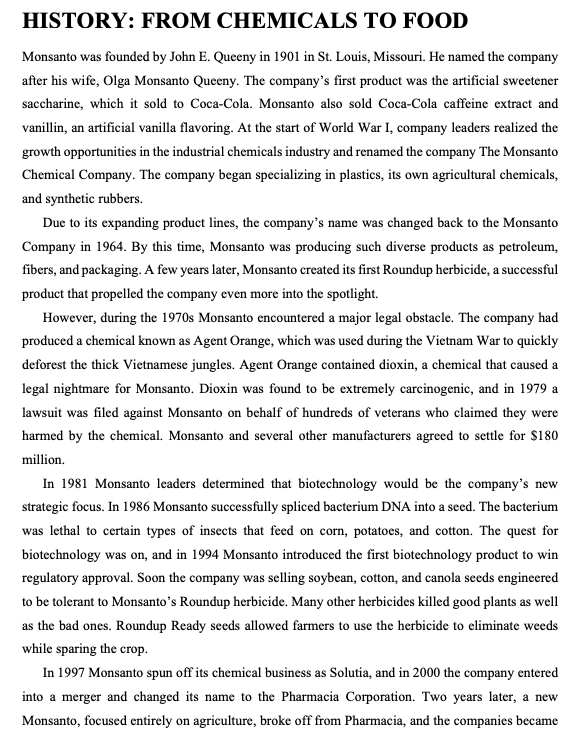
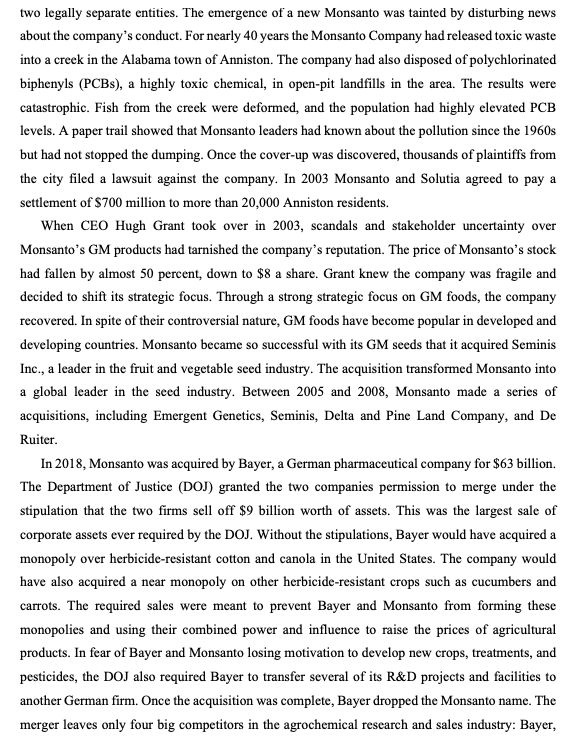
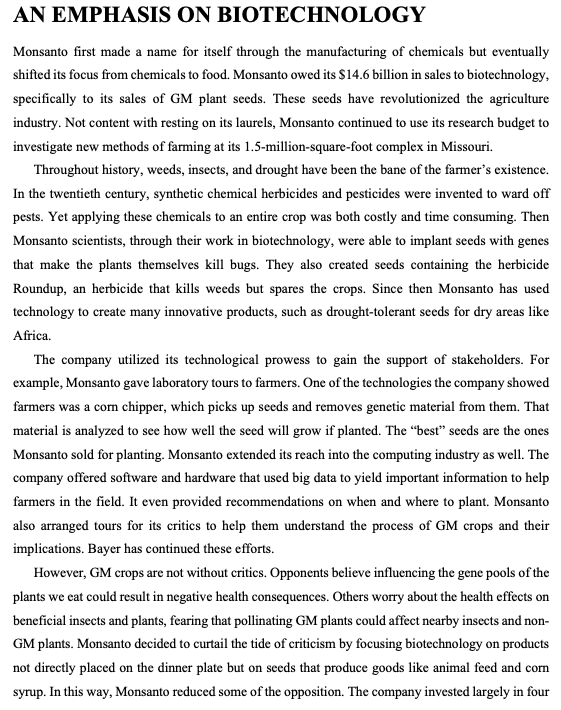
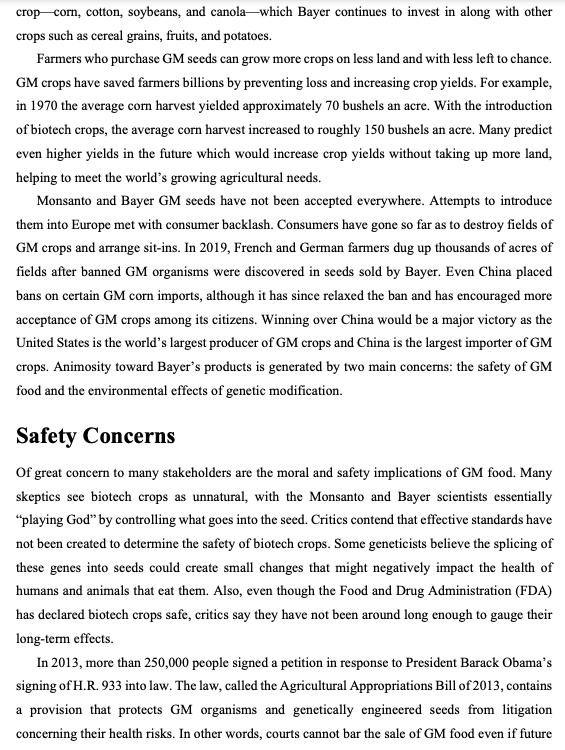
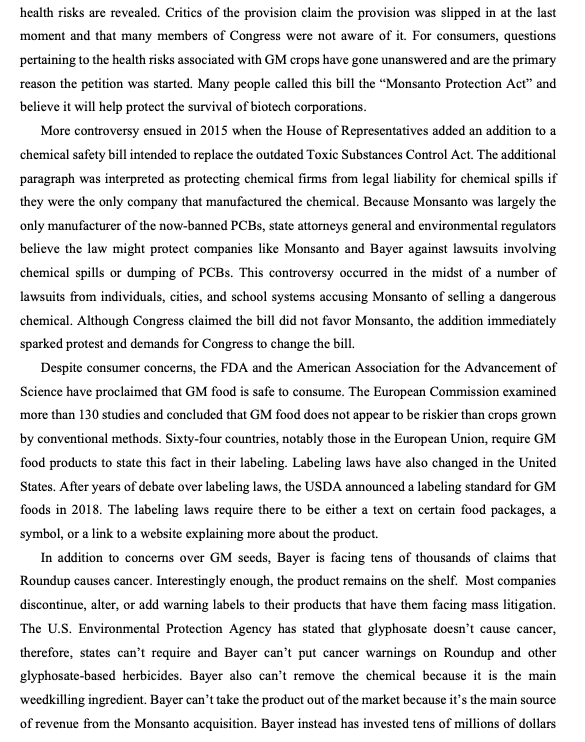
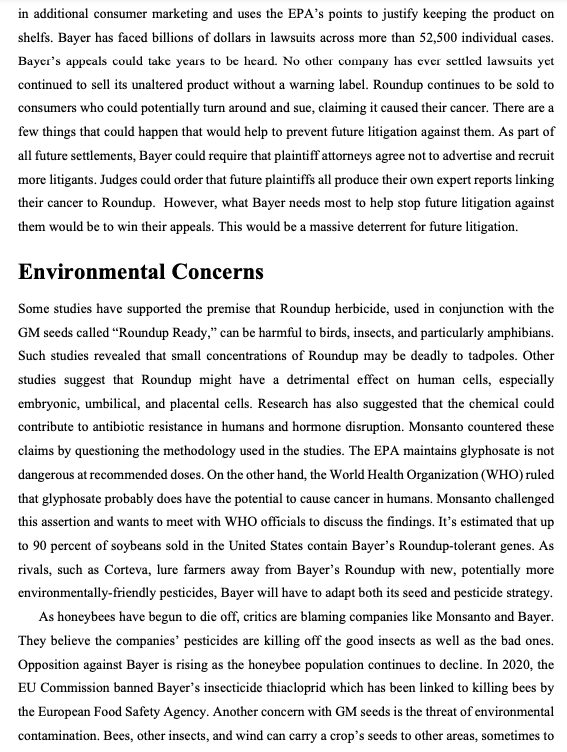
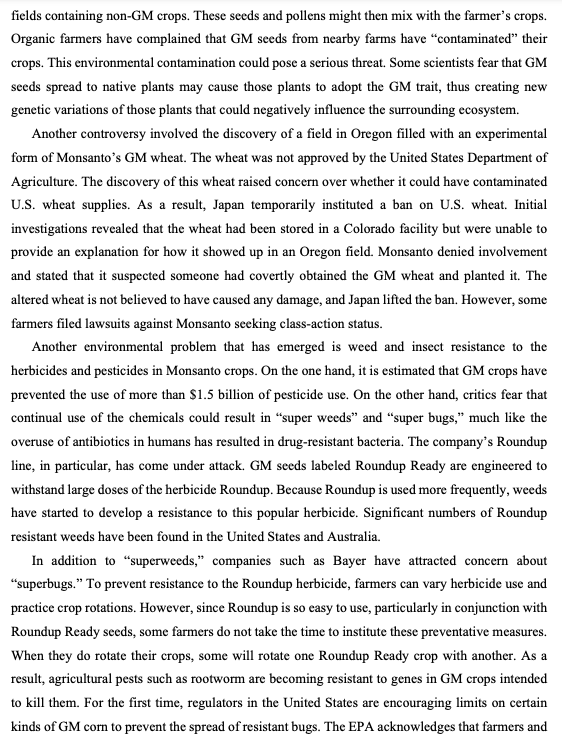

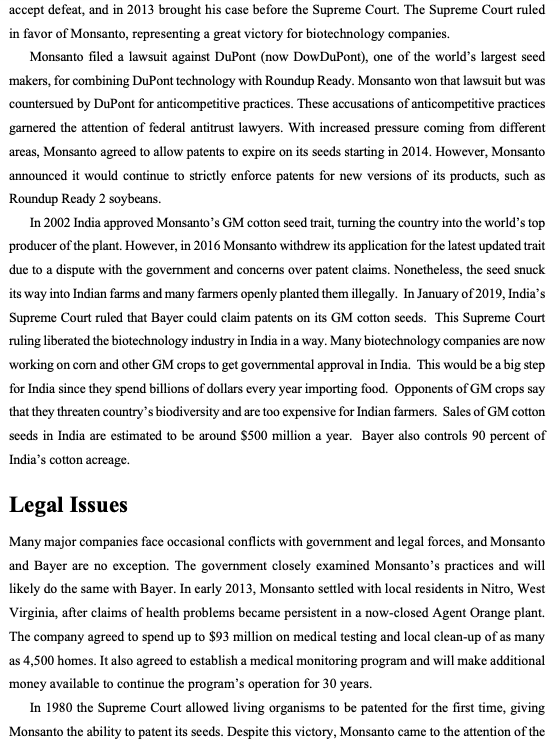
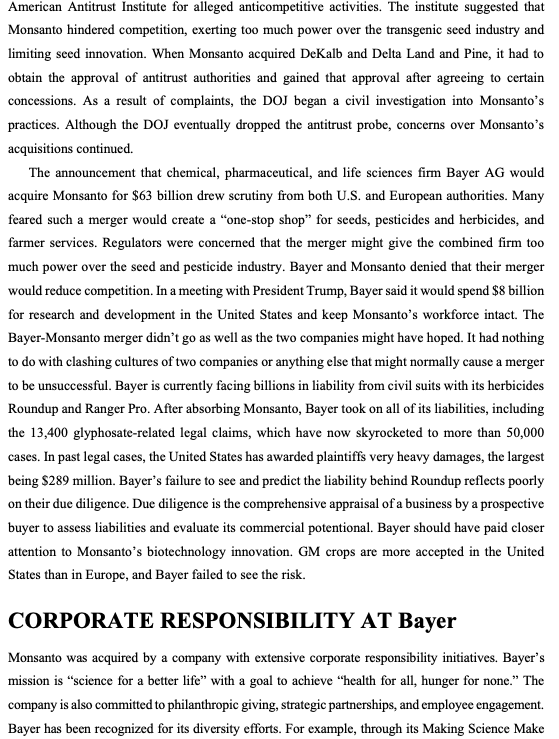
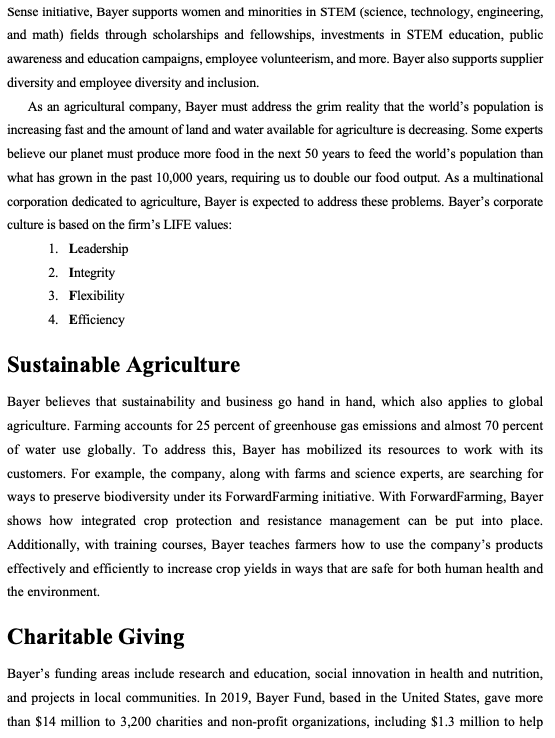
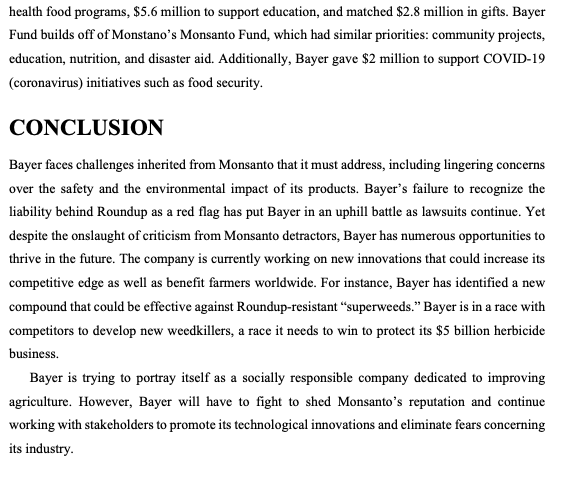
1. Summarize the case.
2. Explain relevant theories, concepts, and models from the textbook.
3. Identify the relevant stakeholders and explain their position/perspective.
4. Explain what the appropriate actions you would take if you were the leader.
5. Explain how your recommendation would impact each stakeholder group
When you think of Monsanto, the phrase genetically modified likely comes to mind. The Monsanto Company was the world's largest seed company, with sales of $14.6 billion in 2017 before it was acquired by Bayer. It specialized in biotechnology, or the genetic manipulation of organisms. Monsanto scientists spent the last few decades modifying crops - often by inserting new genes or adapting existing genes within plant seeds-to meet certain aims, such as higher crop yields or insect resistance. Monsanto developed genetically engineered seeds of plants that can survive weeks of drought, ward off weeds, and kill invasive insects. Monsanto's genetically modified (GM) seeds have increased the quantity and availability of crops, helping farmers worldwide increase food production and revenues. Before being acquired by Bayer, 90 percent of the world's GM seeds were sold by Monsanto or companies that use Monsanto genes. Monsanto met its share of criticism from sources as diverse as governments, farmers, activists, and advocacy groups. Monsanto supporters said the company created solutions to world hunger by generating higher crop yields and hardier plants. Critics accused the multinational giant of attempting to take over the world's food supply and destroying biodiversity. The announcement that Bayer AG acquired Monsanto for $63 billion intensified these concerns because the acquisition meant one company would command over one-fourth of the world's seeds and pesticides market. Since biotechnology is relatively new, critics also express concerns about the possibility of negative health and environmental effects from biotech food. The acquisition was not easy for Bayer which inherited a string of lawsuits related to Monsanto's Roundup herbicide, resulting in millions of dollars spent on litigation and damage payments. This analysis first looks at the history of Monsanto as it progressed from a chemical company to an organization focused on biotechnology. It then examines Monsanto's focus on developing GM seeds, including stakeholder concerns regarding the safety and environmental effects of these seeds. Next, we discuss key ethical concerns, including organizational misconduct, patent issues, and legal issues. We also examine the challenges and opportunities that Bayer may face in the future. HISTORY: FROM CHEMICALS TO FOOD Monsanto was founded by John E. Queeny in 1901 in St. Louis, Missouri. He named the company after his wife, Olga Monsanto Queeny. The company's first product was the artificial sweetener saccharine, which it sold to Coca-Cola. Monsanto also sold Coca-Cola caffeine extract and vanillin, an artificial vanilla flavoring. At the start of World War I, company leaders realized the growth opportunities in the industrial chemicals industry and renamed the company The Monsanto Chemical Company. The company began specializing in plastics, its own agricultural chemicals, and synthetic rubbers. Due to its expanding product lines, the company's name was changed back to the Monsanto Company in 1964. By this time, Monsanto was producing such diverse products as petroleum, fibers, and packaging. A few years later, Monsanto created its first Roundup herbicide, a successful product that propelled the company even more into the spotlight. However, during the 1970s Monsanto encountered a major legal obstacle. The company had produced a chemical known as Agent Orange, which was used during the Vietnam War to quickly deforest the thick Vietnamese jungles. Agent Orange contained dioxin, a chemical that caused a legal nightmare for Monsanto. Dioxin was found to be extremely carcinogenic, and in 1979 a lawsuit was filed against Monsanto on behalf of hundreds of veterans who claimed they were harmed by the chemical. Monsanto and several other manufacturers agreed to settle for $180 million. In 1981 Monsanto leaders determined that biotechnology would be the company's new strategic focus. In 1986 Monsanto successfully spliced bacterium DNA into a seed. The bacterium was lethal to certain types of insects that feed on corn, potatoes, and cotton. The quest for biotechnology was on, and in 1994 Monsanto introduced the first biotechnology product to win regulatory approval. Soon the company was selling soybean, cotton, and canola seeds engineered to be tolerant to Monsanto's Roundup herbicide. Many other herbicides killed good plants as well as the bad ones. Roundup Ready seeds allowed farmers to use the herbicide to eliminate weeds while sparing the crop. In 1997 Monsanto spun off its chemical business as Solutia, and in 2000 the company entered into a merger and changed its name to the Pharmacia Corporation. Two years later, a new Monsanto, focused entirely on agriculture, broke off from Pharmacia, and the companies became two legally separate entities. The emergence of a new Monsanto was tainted by disturbing news about the company's conduct. For nearly 40 years the Monsanto Company had released toxic waste into a creek in the Alabama town of Anniston. The company had also disposed of polychlorinated biphenyls (PCBs), a highly toxic chemical, in open-pit landfills in the area. The results were catastrophic. Fish from the creek were deformed, and the population had highly elevated PCB levels. A paper trail showed that Monsanto leaders had known about the pollution since the 1960s but had not stopped the dumping. Once the cover-up was discovered, thousands of plaintiffs from the city filed a lawsuit against the company. In 2003 Monsanto and Solutia agreed to pay a settlement of $700 million to more than 20,000 Anniston residents. When CEO Hugh Grant took over in 2003, scandals and stakeholder uncertainty over Monsanto's GM products had tarnished the company's reputation. The price of Monsanto's stock had fallen by almost 50 percent, down to $8 a share. Grant knew the company was fragile and decided to shift its strategic focus. Through a strong strategic focus on GM foods, the company recovered. In spite of their controversial nature, GM foods have become popular in developed and developing countries. Monsanto became so successful with its GM seeds that it acquired Seminis Inc., a leader in the fruit and vegetable seed industry. The acquisition transformed Monsanto into a global leader in the seed industry. Between 2005 and 2008, Monsanto made a series of acquisitions, including Emergent Genetics, Seminis, Delta and Pine Land Company, and De Ruiter. In 2018, Monsanto was acquired by Bayer, a German pharmaceutical company for $63 billion. The Department of Justice (DOJ) granted the two companies permission to merge under the stipulation that the two firms sell off $9 billion worth of assets. This was the largest sale of corporate assets ever required by the DOJ. Without the stipulations, Bayer would have acquired a monopoly over herbicide-resistant cotton and canola in the United States. The company would have also acquired a near monopoly on other herbicide-resistant crops such as cucumbers and carrots. The required sales were meant to prevent Bayer and Monsanto from forming these monopolies and using their combined power and influence to raise the prices of agricultural products. In fear of Bayer and Monsanto losing motivation to develop new crops, treatments, and pesticides, the DOJ also required Bayer to transfer several of its R\&D projects and facilities to another German firm. Once the acquisition was complete, Bayer dropped the Monsanto name. The merger leaves only four big competitors in the agrochemical research and sales industry: Bayer, AN EMPHASIS ON BIOTECHNOLOGY Monsanto first made a name for itself through the manufacturing of chemicals but eventually shifted its focus from chemicals to food. Monsanto owed its $14.6 billion in sales to biotechnology, specifically to its sales of GM plant seeds. These seeds have revolutionized the agriculture industry. Not content with resting on its laurels, Monsanto continued to use its research budget to investigate new methods of farming at its 1.5 -million-square-foot complex in Missouri. Throughout history, weeds, insects, and drought have been the bane of the farmer's existence. In the twentieth century, synthetic chemical herbicides and pesticides were invented to ward off pests. Yet applying these chemicals to an entire crop was both costly and time consuming. Then Monsanto scientists, through their work in biotechnology, were able to implant seeds with genes that make the plants themselves kill bugs. They also created seeds containing the herbicide Roundup, an herbicide that kills weeds but spares the crops. Since then Monsanto has used technology to create many innovative products, such as drought-tolerant seeds for dry areas like Africa. The company utilized its technological prowess to gain the support of stakeholders. For example, Monsanto gave laboratory tours to farmers. One of the technologies the company showed farmers was a corn chipper, which picks up seeds and removes genetic material from them. That material is analyzed to see how well the seed will grow if planted. The "best" seeds are the ones Monsanto sold for planting. Monsanto extended its reach into the computing industry as well. The company offered software and hardware that used big data to yield important information to help farmers in the field. It even provided recommendations on when and where to plant. Monsanto also arranged tours for its critics to help them understand the process of GM crops and their implications. Bayer has continued these efforts. However, GM crops are not without critics. Opponents believe influencing the gene pools of the plants we eat could result in negative health consequences. Others worry about the health effects on beneficial insects and plants, fearing that pollinating GM plants could affect nearby insects and nonGM plants. Monsanto decided to curtail the tide of criticism by focusing biotechnology on products not directly placed on the dinner plate but on seeds that produce goods like animal feed and corm syrup. In this way, Monsanto reduced some of the opposition. The company invested largely in four crop-corn, cotton, soybeans, and canola-which Bayer continues to invest in along with other crops such as cereal grains, fruits, and potatoes. Farmers who purchase GM seeds can grow more crops on less land and with less left to chance. GM crops have saved farmers billions by preventing loss and increasing crop yields. For example, in 1970 the average corn harvest yielded approximately 70 bushels an acre. With the introduction of biotech crops, the average corn harvest increased to roughly 150 bushels an acre. Many predict even higher yields in the future which would increase crop yields without taking up more land, helping to meet the world's growing agricultural needs. Monsanto and Bayer GM seeds have not been accepted everywhere. Attempts to introduce them into Europe met with consumer backlash. Consumers have gone so far as to destroy fields of GM crops and arrange sit-ins. In 2019, French and German farmers dug up thousands of acres of fields after banned GM organisms were discovered in seeds sold by Bayer. Even China placed bans on certain GM corn imports, although it has since relaxed the ban and has encouraged more acceptance of GM crops among its citizens. Winning over China would be a major victory as the United States is the world's largest producer of GM crops and China is the largest importer of GM crops. Animosity toward Bayer's products is generated by two main concerns: the safety of GM food and the environmental effects of genetic modification. Safety Concerns Of great concern to many stakeholders are the moral and safety implications of GM food. Many skeptics see biotech crops as unnatural, with the Monsanto and Bayer scientists essentially "playing God" by controlling what goes into the seed. Critics contend that effective standards have not been created to determine the safety of biotech crops. Some geneticists believe the splicing of these genes into seeds could create small changes that might negatively impact the health of humans and animals that eat them. Also, even though the Food and Drug Administration (FDA) has declared biotech crops safe, critics say they have not been around long enough to gauge their long-term effects. In 2013, more than 250,000 people signed a petition in response to President Barack Obama's signing of H.R. 933 into law. The law, called the Agricultural Appropriations Bill of 2013, contains a provision that protects GM organisms and genetically engineered seeds from litigation concerning their health risks. In other words, courts cannot bar the sale of GM food even if future health risks are revealed. Critics of the provision claim the provision was slipped in at the last moment and that many members of Congress were not aware of it. For consumers, questions pertaining to the health risks associated with GM crops have gone unanswered and are the primary reason the petition was started. Many people called this bill the "Monsanto Protection Act" and believe it will help protect the survival of biotech corporations. More controversy ensued in 2015 when the House of Representatives added an addition to a chemical safety bill intended to replace the outdated Toxic Substances Control Act. The additional paragraph was interpreted as protecting chemical firms from legal liability for chemical spills if they were the only company that manufactured the chemical. Because Monsanto was largely the only manufacturer of the now-banned PCBs, state attorneys general and environmental regulators believe the law might protect companies like Monsanto and Bayer against lawsuits involving chemical spills or dumping of PCBs. This controversy occurred in the midst of a number of lawsuits from individuals, cities, and school systems accusing Monsanto of selling a dangerous chemical. Although Congress claimed the bill did not favor Monsanto, the addition immediately sparked protest and demands for Congress to change the bill. Despite consumer concerns, the FDA and the American Association for the Advancement of Science have proclaimed that GM food is safe to consume. The European Commission examined more than 130 studies and concluded that GM food does not appear to be riskier than crops grown by conventional methods. Sixty-four countries, notably those in the European Union, require GM food products to state this fact in their labeling. Labeling laws have also changed in the United States. After years of debate over labeling laws, the USDA announced a labeling standard for GM foods in 2018. The labeling laws require there to be either a text on certain food packages, a symbol, or a link to a website explaining more about the product. In addition to concerns over GM seeds, Bayer is facing tens of thousands of claims that Roundup causes cancer. Interestingly enough, the product remains on the shelf. Most companies discontinue, alter, or add warning labels to their products that have them facing mass litigation. The U.S. Environmental Protection Agency has stated that glyphosate doesn't cause cancer, therefore, states can't require and Bayer can't put cancer warnings on Roundup and other glyphosate-based herbicides. Bayer also can't remove the chemical because it is the main weedkilling ingredient. Bayer can't take the product out of the market because it's the main source of revenue from the Monsanto acquisition. Bayer instead has invested tens of millions of dollars in additional consumer marketing and uses the EPA's points to justify keeping the product on shelfs. Bayer has faced billions of dollars in lawsuits across more than 52,500 individual cases. Bayer's appeals could take years to be heard. No other company has ever settled lawsuits yet continued to sell its unaltered product without a warning label. Roundup continues to be sold to consumers who could potentially turn around and sue, claiming it caused their cancer. There are a few things that could happen that would help to prevent future litigation against them. As part of all future settlements, Bayer could require that plaintiff attorneys agree not to advertise and recruit more litigants. Judges could order that future plaintiffs all produce their own expert reports linking their cancer to Roundup. However, what Bayer needs most to help stop future litigation against them would be to win their appeals. This would be a massive deterrent for future litigation. Environmental Concerns Some studies have supported the premise that Roundup herbicide, used in conjunction with the GM seeds called "Roundup Ready," can be harmful to birds, insects, and particularly amphibians. Such studies revealed that small concentrations of Roundup may be deadly to tadpoles. Other studies suggest that Roundup might have a detrimental effect on human cells, especially embryonic, umbilical, and placental cells. Research has also suggested that the chemical could contribute to antibiotic resistance in humans and hormone disruption. Monsanto countered these claims by questioning the methodology used in the studies. The EPA maintains glyphosate is not dangerous at recommended doses. On the other hand, the World Health Organization (WHO) ruled that glyphosate probably does have the potential to cause cancer in humans. Monsanto challenged this assertion and wants to meet with WHO officials to discuss the findings. It's estimated that up to 90 percent of soybeans sold in the United States contain Bayer's Roundup-tolerant genes. As rivals, such as Corteva, lure farmers away from Bayer's Roundup with new, potentially more environmentally-friendly pesticides, Bayer will have to adapt both its seed and pesticide strategy. As honeybees have begun to die off, critics are blaming companies like Monsanto and Bayer. They believe the companies' pesticides are killing off the good insects as well as the bad ones. Opposition against Bayer is rising as the honeybee population continues to decline. In 2020, the EU Commission banned Bayer's insecticide thiacloprid which has been linked to killing bees by the European Food Safety Agency. Another concern with GM seeds is the threat of environmental contamination. Bees, other insects, and wind can carry a crop's seeds to other areas, sometimes to fields containing non-GM crops. These seeds and pollens might then mix with the farmer's crops. Organic farmers have complained that GM seeds from nearby farms have "contaminated" their crops. This environmental contamination could pose a serious threat. Some scientists fear that GM seeds spread to native plants may cause those plants to adopt the GM trait, thus creating new genetic variations of those plants that could negatively influence the surrounding ecosystem. Another controversy involved the discovery of a field in Oregon filled with an experimental form of Monsanto's GM wheat. The wheat was not approved by the United States Department of Agriculture. The discovery of this wheat raised concern over whether it could have contaminated U.S. wheat supplies. As a result, Japan temporarily instituted a ban on U.S. wheat. Initial investigations revealed that the wheat had been stored in a Colorado facility but were unable to provide an explanation for how it showed up in an Oregon field. Monsanto denied involvement and stated that it suspected someone had covertly obtained the GM wheat and planted it. The altered wheat is not believed to have caused any damage, and Japan lifted the ban. However, some farmers filed lawsuits against Monsanto seeking class-action status. Another environmental problem that has emerged is weed and insect resistance to the herbicides and pesticides in Monsanto crops. On the one hand, it is estimated that GM crops have prevented the use of more than $1.5 billion of pesticide use. On the other hand, critics fear that continual use of the chemicals could result in "super weeds" and "super bugs," much like the overuse of antibiotics in humans has resulted in drug-resistant bacteria. The company's Roundup line, in particular, has come under attack. GM seeds labeled Roundup Ready are engineered to withstand large doses of the herbicide Roundup. Because Roundup is used more frequently, weeds have started to develop a resistance to this popular herbicide. Significant numbers of Roundup resistant weeds have been found in the United States and Australia. In addition to "superweeds," companies such as Bayer have attracted concern about "superbugs." To prevent resistance to the Roundup herbicide, farmers can vary herbicide use and practice crop rotations. However, since Roundup is so easy to use, particularly in conjunction with Roundup Ready seeds, some farmers do not take the time to institute these preventative measures. When they do rotate their crops, some will rotate one Roundup Ready crop with another. As a result, agricultural pests such as rootworm are becoming resistant to genes in GM crops intended to kill them. For the first time, regulators in the United States are encouraging limits on certain kinds of GM corn to prevent the spread of resistant bugs. The EPA acknowledges that farmers and seed companies have not done enough to curb resistance. It began recommending that 35 percent of fields be planted with another crop other than biotech corn. Resistance is of particular concern in Latin America, Africa, and Asia, where farmers may not be as informed of the risks of herbicide and pesticide overuse. DEALING WITH ORGANIZATIONAL ETHICAL ISSUES In addition to concerns over the safety of GM seeds and environmental issues, Monsanto and Bayer have dealt with patent issues and legal issues in addition to concerns about organizational conduct. Organizations face significant risks from strategies and employees striving for high performance standards. Such pressure sometimes encourages employees to engage in illegal or unethical conduct. All firms have these concerns. In the case of Monsanto and Bayer, patents and other legal issues have resulted in legal, ethical, and reputational consequences. Patent Issues Bayer's seeds are protected under patent law. Under the terms of the patent, farmers using Bayer seeds are not allowed to harvest seeds from the plants for use in upcoming seasons. Instead, they must purchase new Bayer seeds each season. By issuing new seeds each year, Bayer ensures it secures a profit as well as maintains control over its property. This patent protection has become a controversial subject among farmers and led to numerous litigation battles for Monsanto. Throughout agricultural history, farmers have collected and saved seeds from previous harvests to plant the following year's crops. Critics argue that requiring farmers to suddenly purchase new seeds each year puts an undue financial burden on them and gives Bayer too much power. However, the law protects Bayer's right to have exclusive control over its creations, and farmers must abide by these laws. When they are found guilty of using Bayer seeds from previous seasons, either deliberately or out of ignorance, they are often fined. In 2007 Monsanto sued Vernon Bowman, an Indiana farmer who Monsanto claims used second-generation Monsanto seeds to plant soybeans. Monsanto claimed its patent protection reaches past first-generation seeds and Mr. Bowman infringed upon its patent. In 2009 the court ruled in favor of Monsanto and ordered Bowman to pay $84,000 in damages. Mr. Bowman did not accept defeat, and in 2013 brought his case before the Supreme Court. The Supreme Court ruled in favor of Monsanto, representing a great victory for biotechnology companies. Monsanto filed a lawsuit against DuPont (now DowDuPont), one of the world's largest seed makers, for combining DuPont technology with Roundup Ready. Monsanto won that lawsuit but was countersued by DuPont for anticompetitive practices. These accusations of anticompetitive practices garnered the attention of federal antitrust lawyers. With increased pressure coming from different areas, Monsanto agreed to allow patents to expire on its seeds starting in 2014. However, Monsanto announced it would continue to strictly enforce patents for new versions of its products, such as Roundup Ready 2 soybeans. In 2002 India approved Monsanto's GM cotton seed trait, turning the country into the world's top producer of the plant. However, in 2016 Monsanto withdrew its application for the latest updated trait due to a dispute with the government and concerns over patent claims. Nonetheless, the seed snuck its way into Indian farms and many farmers openly planted them illegally. In January of 2019, India's Supreme Court ruled that Bayer could claim patents on its GM cotton seeds. This Supreme Court ruling liberated the biotechnology industry in India in a way. Many biotechnology companies are now working on corn and other GM crops to get governmental approval in India. This would be a big step for India since they spend billions of dollars every year importing food. Opponents of GM crops say that they threaten country's biodiversity and are too expensive for Indian farmers. Sales of GM cotton seeds in India are estimated to be around $500 million a year. Bayer also controls 90 percent of India's cotton acreage. Legal Issues Many major companies face occasional conflicts with government and legal forces, and Monsanto and Bayer are no exception. The government closely examined Monsanto's practices and will likely do the same with Bayer. In early 2013, Monsanto settled with local residents in Nitro, West Virginia, after claims of health problems became persistent in a now-closed Agent Orange plant. The company agreed to spend up to $93 million on medical testing and local clean-up of as many as 4,500 homes. It also agreed to establish a medical monitoring program and will make additional money available to continue the program's operation for 30 years. In 1980 the Supreme Court allowed living organisms to be patented for the first time, giving Monsanto the ability to patent its seeds. Despite this victory, Monsanto came to the attention of the American Antitrust Institute for alleged anticompetitive activities. The institute suggested that Monsanto hindered competition, exerting too much power over the transgenic seed industry and limiting seed innovation. When Monsanto acquired DeKalb and Delta Land and Pine, it had to obtain the approval of antitrust authorities and gained that approval after agreeing to certain concessions. As a result of complaints, the DOJ began a civil investigation into Monsanto's practices. Although the DOJ eventually dropped the antitrust probe, concerns over Monsanto's acquisitions continued. The announcement that chemical, pharmaceutical, and life sciences firm Bayer AG would acquire Monsanto for $63 billion drew scrutiny from both U.S. and European authorities. Many feared such a merger would create a "one-stop shop" for seeds, pesticides and herbicides, and farmer services. Regulators were concerned that the merger might give the combined firm too much power over the seed and pesticide industry. Bayer and Monsanto denied that their merger would reduce competition. In a meeting with President Trump, Bayer said it would spend $8 billion for research and development in the United States and keep Monsanto's workforce intact. The Bayer-Monsanto merger didn't go as well as the two companies might have hoped. It had nothing to do with clashing cultures of two companies or anything else that might normally cause a merger to be unsuccessful. Bayer is currently facing billions in liability from civil suits with its herbicides Roundup and Ranger Pro. After absorbing Monsanto, Bayer took on all of its liabilities, including the 13,400 glyphosate-related legal claims, which have now skyrocketed to more than 50,000 cases. In past legal cases, the United States has awarded plaintiffs very heavy damages, the largest being $289 million. Bayer's failure to see and predict the liability behind Roundup reflects poorly on their due diligence. Due diligence is the comprehensive appraisal of a business by a prospective buyer to assess liabilities and evaluate its commercial potentional. Bayer should have paid closer attention to Monsanto's biotechnology innovation. GM crops are more accepted in the United States than in Europe, and Bayer failed to see the risk. CORPORATE RESPONSIBILITY AT Bayer Monsanto was acquired by a company with extensive corporate responsibility initiatives. Bayer's mission is "science for a better life" with a goal to achieve "health for all, hunger for none." The company is also committed to philanthropic giving, strategic partnerships, and employee engagement. Bayer has been recognized for its diversity efforts. For example, through its Making Science Make Sense initiative, Bayer supports women and minorities in STEM (science, technology, engineering, and math) fields through scholarships and fellowships, investments in STEM education, public awareness and education campaigns, employee volunteerism, and more. Bayer also supports supplier diversity and employee diversity and inclusion. As an agricultural company, Bayer must address the grim reality that the world's population is increasing fast and the amount of land and water available for agriculture is decreasing. Some experts believe our planet must produce more food in the next 50 years to feed the world's population than what has grown in the past 10,000 years, requiring us to double our food output. As a multinational corporation dedicated to agriculture, Bayer is expected to address these problems. Bayer's corporate culture is based on the firm's LIFE values: 1. Leadership 2. Integrity 3. Flexibility 4. Efficiency Sustainable Agriculture Bayer believes that sustainability and business go hand in hand, which also applies to global agriculture. Farming accounts for 25 percent of greenhouse gas emissions and almost 70 percent of water use globally. To address this, Bayer has mobilized its resources to work with its customers. For example, the company, along with farms and science experts, are searching for ways to preserve biodiversity under its ForwardFarming initiative. With ForwardFarming, Bayer shows how integrated crop protection and resistance management can be put into place. Additionally, with training courses, Bayer teaches farmers how to use the company's products effectively and efficiently to increase crop yields in ways that are safe for both human health and the environment. Charitable Giving Bayer's funding areas include research and education, social innovation in health and nutrition, and projects in local communities. In 2019, Bayer Fund, based in the United States, gave more than $14 million to 3,200 charities and non-profit organizations, including $1.3 million to help health food programs, $5.6 million to support education, and matched $2.8 million in gifts. Bayer Fund builds off of Monstano's Monsanto Fund, which had similar priorities: community projects, education, nutrition, and disaster aid. Additionally, Bayer gave $2 million to support COVID-19 (coronavirus) initiatives such as food security. CONCLUSION Bayer faces challenges inherited from Monsanto that it must address, including lingering concerns over the safety and the environmental impact of its products. Bayer's failure to recognize the liability behind Roundup as a red flag has put Bayer in an uphill battle as lawsuits continue. Yet despite the onslaught of criticism from Monsanto detractors, Bayer has numerous opportunities to thrive in the future. The company is currently working on new innovations that could increase its competitive edge as well as benefit farmers worldwide. For instance, Bayer has identified a new compound that could be effective against Roundup-resistant "superweeds." Bayer is in a race with competitors to develop new weedkillers, a race it needs to win to protect its $5 billion herbicide business. Bayer is trying to portray itself as a socially responsible company dedicated to improving agriculture. However, Bayer will have to fight to shed Monsanto's reputation and continue working with stakeholders to promote its technological innovations and eliminate fears concerning its industryStep by Step Solution
There are 3 Steps involved in it
Step: 1

Get Instant Access to Expert-Tailored Solutions
See step-by-step solutions with expert insights and AI powered tools for academic success
Step: 2

Step: 3

Ace Your Homework with AI
Get the answers you need in no time with our AI-driven, step-by-step assistance
Get Started


